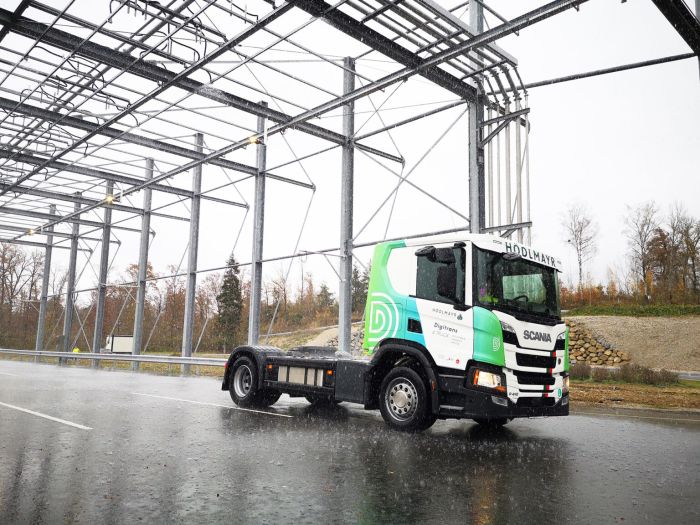






概要
DigiTrans GmbH は、制御された降雨イベントを生成できる車両テスト トラックを開発しました。これは、さまざまな気象条件下での車両性能のテストに非常に役立ちます。テスト トラックの気象条件に関する正確で広範なリアルタイム データ セットを提供するために、DigiTrans GmbH と Campbell Scientific が協力して、最先端の道路気象ステーションを設置しました。
「セント・ヴァレンティンの自動運転試験場に設置したキャンベル・サイエンティフィックのソリューションは、分析上の決定をより良く、より迅速に行うために重要な気象データを提供します。現在、さまざまな人工気象条件と自然気象条件における自動運転車両と運転機能の開発に信頼できるデータがあります。」
—Christoph Feichtinger、DigiTrans GmbH
課題
自動運転車や運転支援車両は、人間の運転者の行動に通常影響を与える気象条件を含むさまざまな条件や状況下でのシステム性能や路面との相互作用を検証するために徹底的にテストする必要があります。自動運転車や運転支援車両の場合、悪天候での安全性の保証と自動意思決定には、広範囲で厳密なテストが必要です。このようなテストは、現実的でありながら制御された条件で実施するのが理想的ですが、これらの条件を再現することは困難な場合があります。
解決策
DigiTrans GmbHは、提示された課題を理解し、独自の降雨システムと特定の種類の降雨を再現する機能を備えた車両テストトラックの開発と構築という画期的なプロジェクトに着手しました。オーストリアのザンクト・ヴァレンティンにあるマグナ・パワートレイン・エンジニアリング・センター・シュタイアーの試験場にある自動運転向けDigiTransテストセンターで、エンジニアは長さ100メートル(328.1フィート)、幅6メートル(19.7フィート)、高さ10メートル(32.8フィート)の屋外降雨プラントを建設しました。降雨プラントは2022年10月に稼働を開始し、屋外灌漑システムを使用して、10~100 mm/時(0.39~3.94インチ/時)の3つの降雨強度を含む、さまざまな液滴サイズと降雨量を生成します。
最も正確で完全な周囲の気象と道路のデータを取得するために、DigiTrans GmbH と Campbell Scientific は協力して、この新しいテスト トラックで関連するすべての周囲および道路状況を測定する高精度の道路気象情報システム (RWIS) を導入しました。これには次のものが含まれます。
- 可視性
- 降水強度と種類
- 風の温度、風向、突風
- 気温
- 相対湿度
- 露点
- 日射
- 現在の天気
- 路面温度
- 道路状況(乾燥、湿潤、濡れ、凍結、雪)
- 摩擦表示
- 除氷剤の存在
- 水膜の高さ
RWIS ステーションは、ヨーロッパ各国の高速道路当局が気象や道路状況の測定に使用している基準に準拠しているだけでなく、それを超えています。そのため、この RWIS ステーションは、ヨーロッパや世界中の RWIS ステーションで収集されたデータと直接比較できる信頼性の高いデータを提供します。
Wintersense IoT (モノのインターネット) スマート センサーがテスト トラックの別の部分に配備され、路面温度 (RST) データ、気温、相対湿度、露点データも追加収集しています。Wintersense センサーは、各プロジェクトのニーズに応じて、トラック沿いのさまざまな場所に簡単に移動できます。たとえば、センサーは、屋外の降雨システムに近い場所や遠い場所の道路や周囲の状況を把握したり、トラックのさまざまなエリアの長期的な変化 (建物や木の影によって寒暖の差が生じる場所など) を調べたりするために使用されます。
DigiTransの自動運転テストセンターでは現在、悪天候下でのさまざまな自動運転機能のテストのほか、自動運転(AD)や先進運転支援システム(ADAS)のテストも実施しています。
テスト トラックのエンド ユーザーは、詳細な分析と、関係するすべての条件と要因の深い理解を可能にする独自のデータ セットにアクセスできるようになりました。これにより、研究から未知の変数が排除されます。また、このデータにより、テスト トラックや、車両が実際の運転テストに投入される実際の道路でのパフォーマンス データの推定精度が向上します。
メリット
- 試験場の顧客と研究者向けに、気象関連および路面状況に関する広範なパラメータに24時間365日リアルタイムでアクセス可能
- DigiTrans GmbHイントラネットネットワーク内のどこからでもライブ測定と履歴記録にアクセスできます。
- データを実際の状況に正確に外挿する能力
- テスト結果の信頼性の向上
- サイト固有の道路天気予報と天気予報に必要なすべての情報
- Wintersenseスマートセンサーの位置を変更することで、試験場の他の部分を簡単に測定できる機能
- 追加のセンサー技術で拡張可能な将来性のあるシステム
ケーススタディの概要
アプリケーション
詳細な車両性能分析のための道路気象データ場所
オーストリア、聖ヴァレンティン寄稿者
Campbell Scientific Germany参加団体
DigiTrans GmbH計測項目
視界、降水量、風の温度と方向、突風、気温、相対湿度、露点、日射量、現在の天気、路面温度関連ウェブサイト
Test Track for Autonomous Driving in St. ValentinPDFで見る